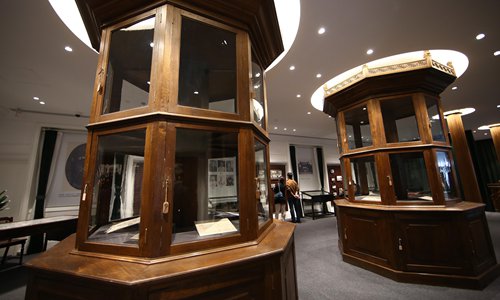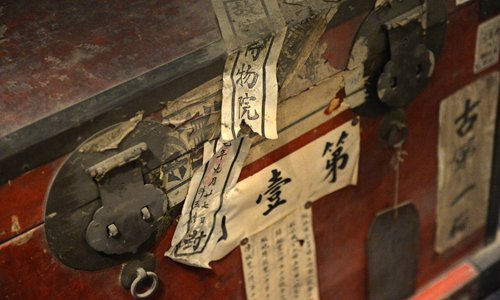
Pictured is the front door of the Hall of Embodied Treasures where Chinese President Xi Jinping and his wife Peng Liyuan welcomed US President Donald Trump and First Lady Melania Trump with afternoon tea on Wednesday. Photo: VCG
Chinese President Xi Jinping and his wife Peng Liyuan invited US President Donald Trump and First Lady Melania Trump to the Palace Museum, also known as the Forbidden City, after the US president started his state visit to China on Wednesday afternoon.
Xi and Peng welcomed the distinguished guests with afternoon tea at the Baoyun Lou, or the Hall of Embodied Treasures, in the southwestern corner of the Forbidden City, the Xinhua News Agency reported.
According to the report, Xi extended a warm welcome to Trump and expressed his gratitude for the hospitality of the Trump family at the Mar-a-Lago estate when he visited the US in April.
Over tea, Trump showed Xi and Peng a video of his granddaughter Arabella Kushner singing in Mandarin and reciting ancient Chinese poems.
Xi spoke highly of the child's Chinese skills and said her performance deserved an "A+." He said Arabella was already a child star in China and hopes she will visit China one day.

Pictured is the front door of the Hall of Embodied Treasures where Chinese President Xi Jinping and his wife Peng Liyuan welcomed US President Donald Trump and First Lady Melania Trump with afternoon tea on Wednesday. Photo: VCG
Reminder of cooperation history
Built in 1915, the Hall of Embodied Treasures features Western architectural styles and was once used to store antiques, but now serves as an exhibition hall for the museum's history.
According to the official website of the Palace Museum, the two-story building is the first large warehouse to be built in contemporary Chinese history and is now used to store more than 200,000 cultural artifacts including paintings, calligraphy works, gold and jade items.
The money used for the hall building came from a share of the US Boxer Indemnity Scholarship Program which was returned to China. Some of the stored antiques in the building have also been moved to other treasure reserves, including the Capital Museum in 1947, said the museum.
In 2015, after two years of meticulous restoration work, the former storage room transformed into an exhibition room, which now tells the story of how the Forbidden City was transformed during the Republic of China period (1912-49). The hall is the only Western-style building that still stands in the Forbidden City today and is open to the public on a regular basis, the People's Daily website, people.cn, reported on Wednesday.
The hall also serves as a reminder of the long history of Sino-US cooperation, according to Chinese experts.
According to Tao Wenzhao, a senior research fellow at the Institute of American Studies under the Chinese Academy of Social Sciences, unlike other buildings in the Palace Museum, Baoyun Lou, as a previous treasure storage trove, can provide soothing tranquility to guests.
Jin Canrong, associate dean of the Department of International Studies at the Renmin University of China, told the Global Times that the location of the hall can instantly relate to Sino-US cooperation history. Besides the returned boxer program funds, it also reflects the times when the two countries fought together against fascism during World War II.
The "tea summit" at the building also sends a strong message to the US - it is cooperation rather than antagonism that is needed between the two countries, he said.

Pictured is the front door of the Hall of Embodied Treasures where Chinese President Xi Jinping and his wife Peng Liyuan welcomed US President Donald Trump and First Lady Melania Trump with afternoon tea on Wednesday. Photo: VCG
Tour for the Trumps
After leaving the hall, the couples walked along the museum's central axis and visited Taihedian, Zhonghedian and Baohedian, the three main halls of the Forbidden City.
In front of Taihedian (the Hall of Supreme Harmony), Xi and Peng took photos with their guests after walking through the Gate of Supreme Harmony.
Taihedian is one of the largest wooden structures in China and the largest hall in the Forbidden City.
Emperors of the Ming (1368-1644) and Qing (1644-1911) dynasties held enthronements and wedding ceremonies in the hall.
During the tour, Xi briefed the visiting couple on the history, architecture and culture of the museum, noting its importance to Chinese history and culture.
The couples also attended an antiques exhibition and watched some being repaired at the museum conservation workshop, known as "the antiques hospital." The workshop is the largest cultural heritage conservation center in China.
After leaving the workshop, the guests were led to watch a Peking Opera performance at the Belvedere of Pleasant Sounds, the largest opera theater in the Forbidden City, initially built during the reign of Emperor Qianlong (1736-1795) of the Qing Dynasty.


